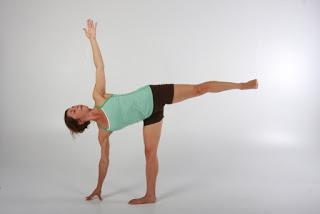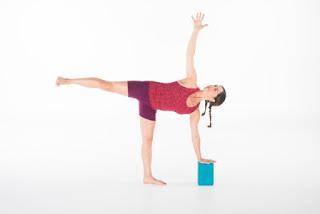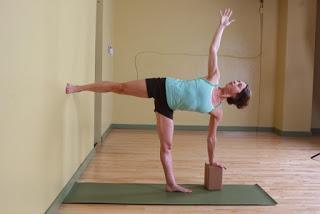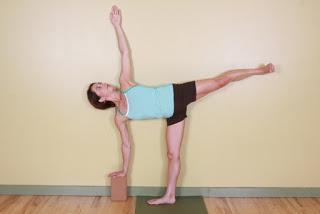This exhilarating and energizing balance pose provides an unusual way to challenge your balance because you side-bend over your standing leg and then twist your torso slightly to open your chest. This pose also helps strengthen and stretch the muscles of your hips, legs, and chest and strengthens the bones of your hips and wrists. Mastering Half Moon pose builds confidence and improves mental concentration. Baxter prescribes this pose for:
- Improving balance and agility
- Osteoporosis
- Building leg strength
- Tight hips
- Boosting energy and mood
- Mental focus
 From Mountain pose, step your feet about 3 ½ to 4 feet apart. Turn your right foot and leg out 90 degrees and then turn your back foot in about 10 degrees, swiveling your hips slightly to the right, but keeping your chest even with the long edge of your mat. Inhale and lift your arms out to your sides, even with your shoulders. Exhale and bend your right knee directly over your ankle toward 90 degrees. You are now in Warrior 2. Inhale and then on your next exhalation, place your left hand on your left hip and tip from your hip joint over your right thigh, bringing your right hand (or fingertips) to the floor just to the outside of your right shin (as in a version of Extended Side Angle Pose) as you come onto the toes of your back foot. Turn your head to look down at your front foot. Step your back foot forward towards your front foot about 6-12 inches, while sliding your right hand directly forward about 1 ½ feet, directly in line your shoulder joint.Now you’re ready to come up! Shift your weight onto your right foot as you straighten your right leg and lift your left leg up in line with your body, parallel with the floor or a bit higher. Still looking down toward your right hand, rotate your chest open to the side and lift your left arm up towards the sky. While in the pose, you can experiment with your gaze, keeping it down or turning your head to look sideways, or even carefully looking up towards your top hand. Maintaining your weight evenly on your standing foot, keep both legs strong and active. Lengthen from your back heel to the crown of your head.To move out of the pose, bring your top hand back to your hip, slightly bend your right knee, and release your back foot lightly down into Extended Side Angle position while shifting your right hand back to the outside of the right foot. Finally, inhale and lift your torso up to vertical into Warrior 2 position, release both arms to your sides, and turn your feet to parallel. Step back into Mountain pose for a few breaths. Repeat the pose on the second side. Version 2: Support for Hand
From Mountain pose, step your feet about 3 ½ to 4 feet apart. Turn your right foot and leg out 90 degrees and then turn your back foot in about 10 degrees, swiveling your hips slightly to the right, but keeping your chest even with the long edge of your mat. Inhale and lift your arms out to your sides, even with your shoulders. Exhale and bend your right knee directly over your ankle toward 90 degrees. You are now in Warrior 2. Inhale and then on your next exhalation, place your left hand on your left hip and tip from your hip joint over your right thigh, bringing your right hand (or fingertips) to the floor just to the outside of your right shin (as in a version of Extended Side Angle Pose) as you come onto the toes of your back foot. Turn your head to look down at your front foot. Step your back foot forward towards your front foot about 6-12 inches, while sliding your right hand directly forward about 1 ½ feet, directly in line your shoulder joint.Now you’re ready to come up! Shift your weight onto your right foot as you straighten your right leg and lift your left leg up in line with your body, parallel with the floor or a bit higher. Still looking down toward your right hand, rotate your chest open to the side and lift your left arm up towards the sky. While in the pose, you can experiment with your gaze, keeping it down or turning your head to look sideways, or even carefully looking up towards your top hand. Maintaining your weight evenly on your standing foot, keep both legs strong and active. Lengthen from your back heel to the crown of your head.To move out of the pose, bring your top hand back to your hip, slightly bend your right knee, and release your back foot lightly down into Extended Side Angle position while shifting your right hand back to the outside of the right foot. Finally, inhale and lift your torso up to vertical into Warrior 2 position, release both arms to your sides, and turn your feet to parallel. Step back into Mountain pose for a few breaths. Repeat the pose on the second side. Version 2: Support for Hand  This alternative is for those who cannot do the full pose with their hand on the floor while completely straightening the standing leg. Experiment to find the right height of the block that allows you to straighten your standing leg without strain and find a good opening of your chest.Start by placing a block on your right side where your right foot will eventually be. To come into the pose, follow the steps for the classic version, except instead when you move from Warrior 2 to bring your hand down, place your right palm or fingertips on the block, which you snuggle close to the outside of your right ankle. Then, as you move into the full pose, slide the block directly forward 1 and ½ feet and directly in line with your shoulder joint. While you are in the pose, follow the instructions for the classic version. To move out of the pose, follow the steps for classic version, remembering to slide the block back to its starting position as you do so. Repeat on the second side. Version 3: Back Foot on Wall
This alternative is for those who cannot do the full pose with their hand on the floor while completely straightening the standing leg. Experiment to find the right height of the block that allows you to straighten your standing leg without strain and find a good opening of your chest.Start by placing a block on your right side where your right foot will eventually be. To come into the pose, follow the steps for the classic version, except instead when you move from Warrior 2 to bring your hand down, place your right palm or fingertips on the block, which you snuggle close to the outside of your right ankle. Then, as you move into the full pose, slide the block directly forward 1 and ½ feet and directly in line with your shoulder joint. While you are in the pose, follow the instructions for the classic version. To move out of the pose, follow the steps for classic version, remembering to slide the block back to its starting position as you do so. Repeat on the second side. Version 3: Back Foot on Wall This alternative is for those with poor balance, weak legs, tight hips, or fear of falling. It also allows you to get a better sense of where your lifted leg is in space, which can help prepare you to practice the classic version.Start by placing a mat with the short end flush against the wall and place two blocks nearby. Next, sit in Staff pose on the mat facing the wall, positioning yourself so when your legs are legs stretched forward the soles of your feet touch the baseboard (move if necessary). Then place the blocks alongside the center of your hips on the edges of your mat (as place holders for where your front foot will go). To come into the pose, start in Mountain pose, with your left side facing the wall, about two feet from the wall. Then step your feet apart so your outer left foot is flush with the wall and your right foot is in line with blocks. (You may have to come out of pose and reposition your front foot a bit forward or back to get the proper alignment.) From here, follow the basic steps for version 1, without raising your back arm for the Warrior 2 position. From there, step your back foot 6-12 inches towards your right foot as you slide your block straight forward about 1 ½ feet and directly under your shoulder joint as you move into the Half Moon pose. When you lift your back leg up, press your left foot into the wall, so your leg is parallel with the floor, toes pointing directly to the left. Use the block to support your hand.While in the pose, press your lifted foot strongly into the wall and maintaining your weight evenly on your standing foot, keep both legs strong and active. You can experiment with your gaze, keeping it down or turning your head to look sideways, or even carefully looking up towards your top hand. Lengthen from your back heel to the crown of your head.To move out of the pose, slightly bend your right knee and release your left foot down to the floor near the wall. Then follow the steps for the classic version. Repeat on the second side. Version 4: Back Against Wall
This alternative is for those with poor balance, weak legs, tight hips, or fear of falling. It also allows you to get a better sense of where your lifted leg is in space, which can help prepare you to practice the classic version.Start by placing a mat with the short end flush against the wall and place two blocks nearby. Next, sit in Staff pose on the mat facing the wall, positioning yourself so when your legs are legs stretched forward the soles of your feet touch the baseboard (move if necessary). Then place the blocks alongside the center of your hips on the edges of your mat (as place holders for where your front foot will go). To come into the pose, start in Mountain pose, with your left side facing the wall, about two feet from the wall. Then step your feet apart so your outer left foot is flush with the wall and your right foot is in line with blocks. (You may have to come out of pose and reposition your front foot a bit forward or back to get the proper alignment.) From here, follow the basic steps for version 1, without raising your back arm for the Warrior 2 position. From there, step your back foot 6-12 inches towards your right foot as you slide your block straight forward about 1 ½ feet and directly under your shoulder joint as you move into the Half Moon pose. When you lift your back leg up, press your left foot into the wall, so your leg is parallel with the floor, toes pointing directly to the left. Use the block to support your hand.While in the pose, press your lifted foot strongly into the wall and maintaining your weight evenly on your standing foot, keep both legs strong and active. You can experiment with your gaze, keeping it down or turning your head to look sideways, or even carefully looking up towards your top hand. Lengthen from your back heel to the crown of your head.To move out of the pose, slightly bend your right knee and release your left foot down to the floor near the wall. Then follow the steps for the classic version. Repeat on the second side. Version 4: Back Against Wall  This alternative is for those with poor balance or with tight hips or legs, and provides more support than version 3 for those with fear of falling.Start by placing a mat lengthwise, flush against the wall, with a block nearby. To come into the pose, start by standing in Mountain pose in the center of the mat with your heels about 4 to 6 inches from the wall. Step your feet apart as in the classic version, and place a block on its highest height between your right foot and the wall. From here, follow the steps for version 2 to move into the pose. When you’re in Half Moon pose, your outer right hip, your shoulder blades, and your upper hand should lightly touch the wall. But your raised leg should be a few inches away from the wall.While in the pose, you can experiment with your gaze, keeping it down or turning your head to look sideways. Maintaining your weight evenly on your standing foot, keep both legs strong and active. Lengthen from your back heel to the crown of your head.To move out of the pose, follow the steps for version 2, using the contact of your outer hip against the wall to maintain your balance if needed. Repeat on the second side. Subscribe to Yoga for Healthy Aging by Email ° Follow Yoga for Healthy Aging on Facebook ° Join this site with Google Friend Connect
This alternative is for those with poor balance or with tight hips or legs, and provides more support than version 3 for those with fear of falling.Start by placing a mat lengthwise, flush against the wall, with a block nearby. To come into the pose, start by standing in Mountain pose in the center of the mat with your heels about 4 to 6 inches from the wall. Step your feet apart as in the classic version, and place a block on its highest height between your right foot and the wall. From here, follow the steps for version 2 to move into the pose. When you’re in Half Moon pose, your outer right hip, your shoulder blades, and your upper hand should lightly touch the wall. But your raised leg should be a few inches away from the wall.While in the pose, you can experiment with your gaze, keeping it down or turning your head to look sideways. Maintaining your weight evenly on your standing foot, keep both legs strong and active. Lengthen from your back heel to the crown of your head.To move out of the pose, follow the steps for version 2, using the contact of your outer hip against the wall to maintain your balance if needed. Repeat on the second side. Subscribe to Yoga for Healthy Aging by Email ° Follow Yoga for Healthy Aging on Facebook ° Join this site with Google Friend Connect

